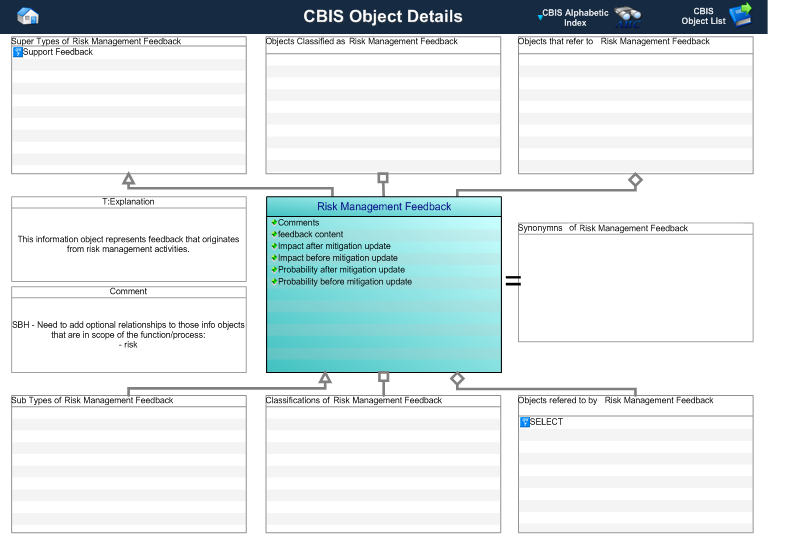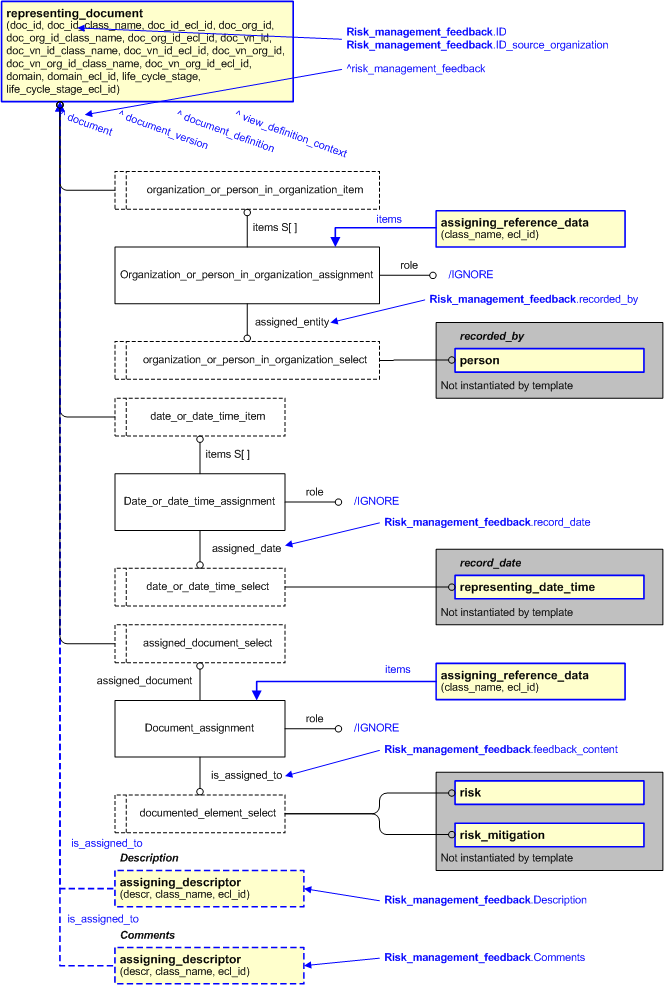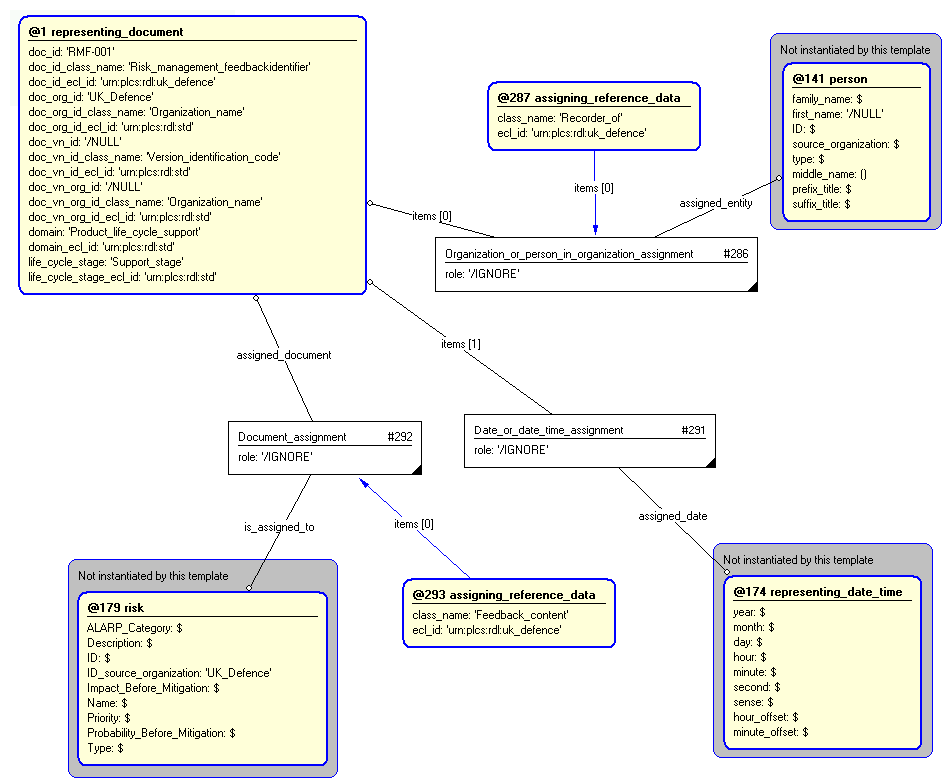Template:— risk_management_feedback (rsk_mgmt_fdbk)
Context:— UK_Defence |
Date: 2010/03/15 15:08:44
Revision: 1.4
|
This section specifies the template risk_management_feedback.
NOTE
The template has been defined in the context of
UK_Defence.
Refer to the business context for details of related templates.
NOTE
An explanation of a template and the associated instantiation path is
provided in the
Template overview
section.
This template describes how to represent risk management feedback in terms of PLCS model elements (templates, entities and
reference data).
A Risk management feedback represents information that originates from the risk management activities.
This information object represents feedback that originates from risk management activities.
Figure 1 — A MOOD Business Architect representation of the Business Object: Risk Management Feedback
The attributes of the Risk Management Feedback object are tabled below.
|
Attribute name
|
Attribute description
|
Attribute type
|
Optionality
|
| Comments |
This is the description of the comments made as part of the risk management feedback. |
intrinsic |
Optional |
| feedback content |
This is the reference to the contents of the risk feedback report. |
SELECT |
Mandatory |
| Impact after mitigation update |
This is the description of the impact of the risk after mitigation action. |
intrinsic |
Mandatory |
| Impact before mitigation update |
This is the description of the impact of the risk before the mitigation action. |
intrinsic |
Mandatory |
| Probability after mitigation update |
This is the probability of the the risk event after mitigation action. |
intrinsic |
Mandatory |
| Probability before mitigation update |
This is the probability of the risk event before mitigation action. |
intrinsic |
Mandatory |
Table 1 — Risk Management Feedback attribute details
NOTE
This template is dependent on entities in the ISO10303-239 Edition 2 schema.
The EXPRESS-G diagram in
Figure
2
shows the templates and EXPRESS entities that are required
to represent the template
"risk_management_feedback".
The text highlighted in blue shows the template parameters.
Figure 2 — An EXPRESS-G representation of the Information model for risk_management_feedback
The graphic for the template to be used in other EXPRESS-G diagrams
is shown in Figure
3
below.
Figure 3 — The graphical representation of the risk_management_feedback template
The following input parameters are defined for this template:
This is the description of the comments made as part of the risk management feedback.
feedback_content (Type=
'ENTITY
(
![[warning:]]() Error ER1: The entity Risk_perception does not exist
Error ER1: The entity Risk_perception does not existRisk_perception)'
![[warning:]]() Error EXP-1: The EXPRESS entity Risk_perception
Error EXP-1: The EXPRESS entity Risk_perception
does not exist in data/schemas/ap239_arm_lf.xml.)
This is the reference to the contents of the risk feedback report.
This is a description of the risk management feedback report.
This is the identifier of the risk management feedback report.
The organization that created the associated identifier. Additionally
a Person or Information System could be defined when either of these are the source; see Identifier template characterizations
This is the date and time on which the risk management feedback report was made.
This is the reference to the person or system which recorded the feedback
The following reference parameters are defined for this template:
Allow the
Document
entity instantiated in this path to be referenced when this template is used.
Note: The
Document
entity can be referenced in a template path by:
%^target = $risk_management_feedback.risk_management_feedback%
where
target
is the parameter to which the
Document
is bound.
The instantiation path shown below specifies the entities that are to be
instantiated by the template.
A description of templates and the syntax for the instantiation path is
provided in the
Templates Help/Information section.
-- Representing document /
representing_document(
doc_id=@ID,
doc_id_class_name='Risk_management_feedback_identifier',
doc_id_ecl_id='urn:plcs:rdl:uk_defence',
doc_org_id=@ID_source_organization,
doc_org_id_class_name='Organization_name',
doc_org_id_ecl_id='urn:plcs:rdl:std',
doc_vn_id=/NULL,
doc_vn_id_class_name='Version_identification_code',
doc_vn_id_ecl_id='urn:plcs:rdl:std',
doc_vn_org_id='/NULL',
doc_vn_org_id_class_name='Organization_name',
doc_vn_org_id_ecl_id='urn:plcs:rdl:std',
domain='Product_life_cycle_support',
domain_ecl_id='urn:plcs:rdl:std',
life_cycle_stage='Support_stage',
life_cycle_stage_ecl_id='urn:plcs:rdl:std')/
%^risk_management_feedback = $representing_document.document%
-- Create relationship to recorded_by Organization_or_person_in_organization_assignmentOrganization_or_person_in_organization_assignment.items ->
^risk_management_feedback
Organization_or_person_in_organization_assignment.assigned_entity ->
@recorded_byOrganization_or_person_in_organization_assignment.role = '/IGNORE'
%^rec_by =
Organization_or_person_in_organization_assignment%
/
assigning_reference_data(
class_name='Recorder_of',
ecl_id='urn:plcs:rdl:uk_defence',
items=^rec_by)/
-- Record date Date_or_date_time_assignmentDate_or_date_time_assignment.role = '/IGNORE'
Date_or_date_time_assignment.items ->
^risk_management_feedback
Date_or_date_time_assignment.assigned_date ->
@record_date-- [optional Description] /
assigning_descriptor(
descr=@Description,
class_name='Description',
ecl_id='urn:plcs:rdl:uk_defence',
is_assigned_to=^risk_management_feedback)/
-- [optional Comments] /
assigning_descriptor(
descr=@Comments,
class_name='Comments',
ecl_id='urn:plcs:rdl:uk_defence',
is_assigned_to=^risk_management_feedback)/
-- Related feedback_content Document_assignmentDocument_assignment.role = '/IGNORE'
Document_assignment.assigned_document ->
^risk_management_feedback
Document_assignment.is_assigned_to ->
@feedback_content%^feedback_cont =
Document_assignment%
/
assigning_reference_data(
class_name='Feedback_content',
ecl_id='urn:plcs:rdl:uk_defence',
items=^feedback_cont)/
The following entities are instantiated with attributes as specified:
The instance diagram in Figure
4
shows an example of the EXPRESS entities and templates that are instantiated by the template:
/risk_management_feedback(ID='RMF-001', ID_source_organization='UK_Defence')/
(an illustration of the consolidated risk_management_feedback template is shown in
Figure
5 below.)
Figure 4 — Entities instantiated by risk_management_feedback template
The instance diagram in
Figure
5
shows the graphic symbol for the template that is to be
used in other instance diagrams. The example template is:
/risk_management_feedback(ID='RMF-001', ID_source_organization='UK_Defence')/
Figure 5 — Instantiation of risk_management_feedback template
Characterizations
No common characterizations of the template
risk_management_feedback
have been identified. However, the ISO 10303-239 EXPRESS model
may enable other assignments to the entities instantiated by the template.




